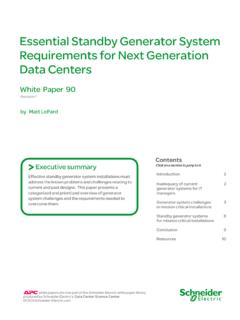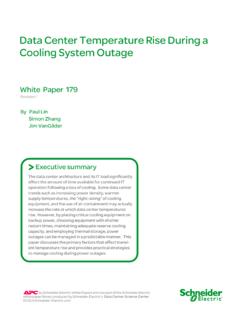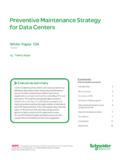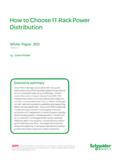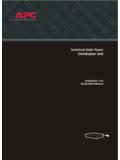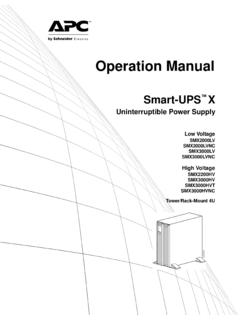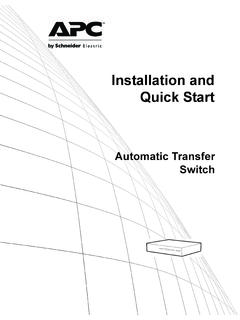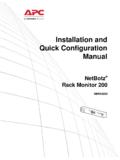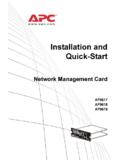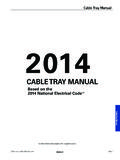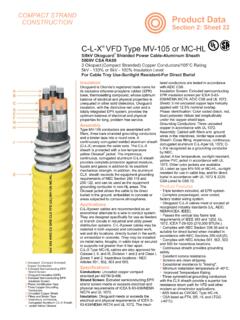Transcription of Comparing Data Center Power Distribution Architectures
1 Comparing data Center Power Distribution Architectures Revision 3 by Neil Rasmussen and Wendy Torell White Paper 129 Significant improvements in efficiency, Power density, Power monitoring, and reconfigurability have been achieved in data Center Power Distribution , increasing the options available for data centers. This paper compares five Power Distribution approaches including panelboard Distribution , field-wired PDU Distribution , factory-configured PDU Distribution , floor-mount modular Power Distribution , and modular busway, and describes their advantages and disadvantages.
2 Guid-ance is provided on selecting the best approach for specific applications and constraints. Executive summary by Schneider Electric White Papers are now part of the Schneider Electric white paper library produced by Schneider Electric s data Center Science Center Revision notice > This original version of this paper focused on the benefits of floor-mount modular Distribution . This revision discusses the five common Distribution approaches and provides guidance for selecting the best approach for a given application.
3 Comparing data Center Power Distribution Architectures Schneider Electric data Center Science Center Rev 3 2 Many existing data centers utilize the same Power Distribution architecture to get Power to their IT equipment that was developed for data centers approximately 40 years ago. There have been dramatic changes, however, in how Power is utilized in data centers that have challenged this architecture, specifically driven by increasing Power density, the increasing number of separate IT devices within the data Center , and the need to add and remove IT devices on a continuous basis.
4 Improved systems allow IT racks to be installed or changed without any new wiring, distribute Power overhead, support rack densities up to 30 kW with a single flexible Power feed, improve electrical efficiency, are instrumented for Power at the branch circuit, and have a standard capacity management system. This paper compares the five Power Distribution approaches seen in data centers today, including panelboard Distribution , traditional field-wired PDUs ( Power Distribution units), traditional factory-configured PDUs, floor-mount modular Power Distribution , and modular overhead (or underfloor) Power busway (see Figure 1).
5 The advantages and disadvantages of each approach are discussed, and guidance is provided on selecting the optimal approach for specific applications and constraints. Panelboard distributionTraditional PDU distributionfield-wired PDUfactory-configured PDUM odular distributionFloor-mount distributionBusway Distribution Traditional data centers consisted of a small number of large IT devices that were rarely changed except during the scheduled downtime of a major IT upgrade. The low Power density of these facilities required a low volume of under-floor air, and typically less than one branch circuit for every three square meters of computer room.
6 Table 1, on the other hand, summarizes the characteristics of the IT equipment in many data centers today. Characteristic Description Number of IT devices Instead of a few large IT devices, data centers may contain thousands of plug-in devices with separate Power cords, requiring many more Power receptacles Frequency of IT refreshes IT devices are changed often within the lifetime of the data Center , changing the Power requirements or receptacle requirements at a rack location; New Power circuits must frequently be added to a live data Center without disturbing nearby existing IT loads Power density of IT racks The per-rack Power density has increased greatly, often requiring multiple branch circuits per cabinet.
7 The number of Power feeds has clogged the under-floor air plenum with conduits, blocking the airflow and making changes very difficult Type of IT devices Dual Power path systems are commonly implemented, requiring assurance that no circuit is loaded above 50% Introduction Figure 1 Five approaches to distributing Power to IT racks data Center IT characteristics Table 1 IT characteristics that impact Power Distribution selection Comparing data Center Power Distribution Architectures Schneider Electric data Center Science Center Rev 3 3 In the majority of the world.
8 Power is distributed to IT loads at 400/230 VAC. In North America, however, Power is traditionally distributed at 208/120 VAC, which results in deficien-cies including greater cost, lower efficiency, and greater space consumed. Another operating voltage for North America offers advantages over 208/120 VAC. Using 415/240 VAC distribu-tion enables higher density per rack without adding extra circuit breakers as would be the case with 208/120 VAC Distribution . White Paper 128, High-Efficiency AC Power Distribution for Green data Centers, discusses the benefits of 415/240 VAC over 208/120 VAC.
9 In panelboard Distribution , the main data Center Power is distributed to multiple wall-mounted panelboards, such as those in Figure 2. Panelboards (typically rated from kVA to 75 kVA) may come assembled by the vendor or they may be assembled in the field by the electrical contractor. Individual branch circuits or Power cables are cut, terminated, and connected in the field by the contractor. The cables are run either overhead in cable trays (also called ladder trays), or they are run under the raised floor (sometimes in trays under the floor, and sometimes placed directly on the floor) to provide Power close to the IT rack enclosures.
10 Wall mount panelboards are a very low cost Power Distribution strategy, made up of parts that an electrician can acquire in days, not weeks, to implement quickly. This approach is very much custom engineered to meet the unique needs of a particular data Center Advantages Lowest first cost, primarily driven by lower cost components Accommodates unusual physical room constraints Electrician has more flexibility in breaker and cable combinations, since they are not choosing from pre-configured assemblies Parts can be obtained very fast.
